The oil and gas industry is making strides when it comes to the utilization of trending technologies like the Internet of Things (IoT) and artificial intelligence (AI). Over the last decade and a half, the industry has been adopting modern technologies to benefit many facets of everyday life for people in this field.

Adopting trending technologies in the oil and gas industry enables companies to cut costs, streamline operations, and make the best use of resources.
Let’s take a look at some of the innovative technologies being utilized in this rugged industry.
How Analytics Are Helping the Industry Evolve
A survey from General Electric and Accenture in 2018 showed that 81% of oil and gas company executives considered Big Data to be among the top three priorities of the industry.
Companies in the oil and gas industries rely on Big Data to collect and analyze data to make smarter fact-based decisions. Analytics are commonly used to make more informed decisions about drilling, exploration, company costs, and on-site operations.
Big Data is a technology used to collect information on six main characteristics: volume, variety, velocity, veracity, value, and complexity. Big Data technology analyzes mass amounts of data that would otherwise be too complex for normal data-processing application software to analyze.
Some specific examples of the oil and gas industry leveraging Big Data and analytics are to analyze seismic and microseismic data to estimate where oil pockets are and determine the best places to drill and use sensors to warn crew members when equipment is malfunctioning to predict and prevent operational risks.
AI and IoT Is the Future in Oil and Gas
AI and IoT are technologies that many industries are adopting — and they’re especially useful in an industry as lucrative and dangerous as oil and gas.
One major benefit of leveraging artificial intelligence in the oil and gas industry is keeping workers out of danger. Sensors are an integral part of AI systems that can read when temperatures are dangerously high, when employees have been exposed to toxic chemicals, and when pressure levels are dangerously high. Knowing this information in real-time enables managers and crew members to get co-workers out of harm’s way.
The Internet of Things makes it possible to get real-time updates no matter where crew members are — whether working remotely or on-site. IoT technologies enable oil and gas companies to give live updates on products and check for any bottlenecks in various processes.
AI technology is also used to detect defects and malfunctions in machinery, equipment, and pipes. When issues are proactively found and addressed, they can be fixed before severe equipment damage or workplace injuries occur. Defects found and not addressed in production operations can lead to upstream issues and increased costs.
In most cases, the cost savings of implementing AI and IoT technologies will be worth the time and money to detect and fix just one potential issue.
Automation and Robotics
The use of automation and robotics in the oil and gas industry has been instrumental in streamlining processes and improving workplace safety.
There are many repetitive, mundane, and dangerous tasks in the oil and gas industry that automatons and robots are taking over. One example of a dangerous and repetitive task is connecting drill pipes deep beneath the ocean and under rocks. Leveraging robots to connect drilling pipes keeps crews out of danger and makes the process more efficient since there is no chance for human error.
Another significant way robots are taking human crews out of dangerous situations is by handling oil tank cleaning. When oil sits in a container or tank for extended periods of time, the sludge builds up. When the sludge sits for too long in oil, bacteria forms, and compromises the oil’s contents, often making it unusable.
Traditionally, tank cleaning is done by human crews. Tank cleaning involves humans entering confined spaces to manually clean the tanks and being exposed to potentially harmful chemicals and toxins. Instead of manual cleaning, tank-cleaning robots are replacing human crews. This removes the vast majority of the risk and labor for human workers; crew members guide the robot while in the tank to clean it and remove sludge.
Don’t Fight the Trends
Through innovative technology, the oil and gas industry continues to lower operational costs, analyze data to make better business predictions, and increase workplace safety. As automation and technologies get more precise and advanced, we will continue to see them take over the most hazardous jobs, and even more, tasks will be offloaded from human crews.
Whether it’s implementing Big Data to predict plentiful drilling sites or utilizing robotic tank cleaning to keep human crews out of dangerous situations, all of the trending technologies above are beneficial in the oil and gas industry.
Modern technologies are helping make oil and gas jobs easier, safer, and more cost-effective while streamlining processes and operations. Start leveraging them as soon as possible to stay on the cutting edge and one step ahead of the competition.
